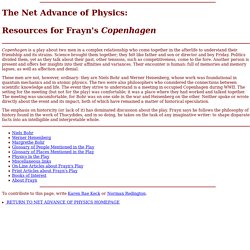

Nondestructive Evaluation Physics : Atomic Elements. Nineteenth Century Wave Theories. 5.1 Young’s double-slit experiments British natural philosopher Thomas Young provided strong evidence for Dutch natural philosopher Christiaan Huygens’ wave theory of light (discussed in Chapter 3) in 1803, when he published the results of his double-slit experiments.[1] Young repeated earlier experiments with diffraction (discussed in Chapter 2) but passed the light through more than one slit.

Young stated that: If light is composed of particles, then they should each pass through a single slit, eventually creating two bright patterns on the other side.If light is composed of waves, then the slits will cause diffraction, and the light should produce a predictable interference pattern, just like water waves do. Young showed that light behaves like a wave and creates an interference pattern, which is a consequence of the superposition principle. 5.1.1 The superposition principle 5.2 Polarisation 5.3 Electromagnetic radiation Faraday discovered the Faraday effect in 1845. 5.4 The aether. The Cathode Ray Tube site, Crookes tubes. The Cathode Ray Tube site electronic glassware History and Physics Instruments Crookes tubesRadiant matter The first page Crookes Maltese Cross tubesIn front a small early (French?)

Modell with the cross falling backwards, in the back a Pressler tube with the cross falling to the front. The Maltese Cross tube (Crookes nr 9) This is one of the most famous Crookes tubes. Mineral tubes (Crookes nr 4) After Crookes made his first announcement in 1879 he made a second one in 1881 about the fluorescent and phosphorescent properties of different materials in his (pdf) article Discontinuous Phosphorescent Spectra in High Vacua. Here is a list of some common used minerals in Crookes tubes. Johann Wilhelm Hittorf 1824 - 1914. Martindale's "The Reference Desk" - Business, Math, Science, Engineering, Technology, Language, Medical, Veterinary, Livestock, Gardening, Photography, Music, Recipes, etc.
HyperPhysics Concepts. About HyperPhysics Rationale for Development HyperPhysics is an exploration environment for concepts in physics which employs concept maps and other linking strategies to facilitate smooth navigation. For the most part, it is laid out in small segments or "cards", true to its original development in HyperCard. Tutorials, Electronics made EASY, Williamson Labs. Bell System Memorial Home Page. Repeat Famous Science Experiments and Inventions & Hands on Activities.
Fowler's Physics Applets. This applet is a slightly simplified representation of Ptolemy's mode for the motion of the inner planets.

From our modern perspective, the planets do not go in perfect circles around the Sun. If they did, our simplified Ptolemy model of uniform circular motion around an epicycle which is itself precessing uniformly would represent exactly the motion of the planet through the heavens. In fact, this is very close to the truth: the true orbits are ellipses, but very close to circular. Ptolemy's model had to be refined with small extra epicycles, or not quite uniform circular motion. Here we just want to emphasize the main point: how this simple model can successfully account for the motion of the planets in the heavens to a very good approximation, but keeps the Earth itself at rest. Point to notice: Venus and Mercury never get very far from the Sun in the sky.
PHYS591: Theories of Gravitation. Michael Frayn's "Copenhagen" Copenhagen is a play about two men in a complex relationship who come together in the afterlife to understand their friendship and its strains.

Science brought them together; they felt like father and son or director and boy Friday. Politics divided them, yet as they talk about their past, other tensions, such as competitiveness, come to the fore. Another person is present and offers her insights into their affinities and variances. Their encounter is human: full of memories and memory lapses, as well as affection and denial. These men are not, however, ordinary: they are Niels Bohr and Werner Heisenberg, whose work was foundational in quantum mechanics and in atomic physics. The emphasis on historicity (or lack of it) has dominated discussion about the play. To contribute to this page, write Karen Rae Keck or Norman Redington. The Net Advance of Physics. PHYSICS, RELATIVITY, GRAVITATION, COSMOLOGY AND MATHEMATICS - NEW THEORIES AND FORMULATIONS. 15.6.3 The Optical Life - Transformations of Optics in the Pre-modern Period. This project studies the long-term development of optics between ca. 1400 and ca. 1700.

Its central objects of study are the practices of optics and how these practices – if you wish, the ‘optical life’ - interacted with changing images of the discipline of optics, i. e. the changing boundaries, scope and aims of optics. The 14th century saw the establishment of a highly-regarded discipline of optics – known as perspectiva – which was central in the medieval map of knowledge and strongly embedded within the authoritative educational context of the universities. Relativity. The Exploration of the Earth's Magnetosphere" Physics Resources. PhET: Free online physics, chemistry, biology, earth science and math simulations. Physics & Math.
Michael Nauenberg Homepage. New Journal of Physics. Within the last two decades, quantum technologies (QT) have made tremendous progress, moving from Nobel Prize award-winning experiments on quantum physics (1997: Chu, Cohen-Tanoudji, Phillips; 2001: Cornell, Ketterle, Wieman; 2005: Hall, Hänsch-, Glauber; 2012: Haroche, Wineland) into a cross-disciplinary field of applied research.

Technologies are being developed now that explicitly address individual quantum states and make use of the ‘strange’ quantum properties, such as superposition and entanglement. HyperPhysics. Curso Interactivo de Física en Internet. Si los applets de Java no funcionan en su ordenador, pruebe la tercera versión del Curso Interactivo de Física en Internet .

Los programas interactivos están hechos con el estándar HTML5 canvas. No precisan de programas externos (plug-in) para interpretar el código. Se pueden ver también en tablets y smartphones El Curso Interactivo de Física en Internet, es un curso de Física general que trata desde conceptos simples como el movimiento rectilíneo hasta otros más complejos como las bandas de energía de los sólidos. La interactividad se logra mediante los 646 applets insertados en sus páginas webs que son simulaciones de sistemas físicos, prácticas de laboratorio, experiencias de gran relevancia histórica, problemas interactivos, problemas-juego, etc.
El Curso Interactivo de Física en Internet cambia de estructura y de presentación e incorpora nuevos contenidos: problemas resueltos, clips de vídeo y fotografías de prácticas de laboratorio y demostraciones de aula. Journal of Physics: Condensed Matter. Caderno de Física da UEFS. New Journal of Physics. Papers in Physics. Papers in Physics publishes original research in all areas of physics and its interface with other subjects.

The scope includes, but is not limited to, physics of particles and fields, condensed matter, relativity and gravitation, nuclear physics, physics of fluids, biophysics, econophysics, chemical physics, statistical mechanics, soft condensed matter, materials science, mathematical physics and general physics. Contributions in the areas of foundations of physics, history of physics and physics education are not considered for publication. Articles published in Papers in Physics contain substantial new results and ideas that advance the state of physics in a non-trivial way.
Articles are strictly reviewed by specialists prior to publication. Papers in Physics highlights outstanding articles published in the journal through the Editors' choice section. Papers in Physics offers two distinct editorial treatments to articles from which authors can choose.